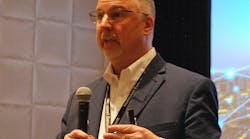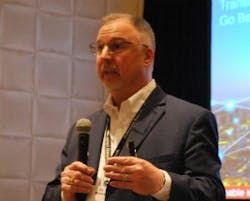“We bring grid automation, cybersecurity, data analytics, data science—a holistic approach for optimization, safety and reliability.” Honeywell Smart Energy’s Ed Miszka explained how the company can help its utility customers to meet the today’s fast-evolving challenges.
Distributed renewables, managing losses and the ability to monitor—and turn off—customers are driving a new generation of data gathering, two-way communications and smart meter systems for power, gas and water utilities. “How do we wrap ourselves around automation at the grid to benefit utilities and their customers?” asked Ed Myszka, vice president and general manager, Honeywell Smart Energy. “Their traditional role is to get electrons to consumers. Now, they are trying to get data back on a grid that wasn’t designed for that.”
Myszka spoke to attendees of his session, “Redefining How the World Uses Energy” at Honeywell Users Group Americas 2019 this week in Dallas.
Major trends
First, utilities need access to data. “We see public wireless as a competitive alternative to our own networks. We need to move the right information, not just a lot of data,” Myszka said.
Second, utilities are dealing with disruptive forces including decarbonization, with a proliferation of renewables such as solar and the accompanying need for storage. Digitalization is also disruptive, with its emphasis on bits and bytes versus electron flow. Decentralization of assets presents significant challenges, including transactional interactions. “The state of California is requiring photovoltaics (PV) on every new building,” Myszka said. “That brings transactional interactions—will they sell to you, or to a different utility, or sideways to their neighbors?”
Electric vehicles represent an increasingly distributed load that can move around at different times to different places. “We need electricity at the right place at the right time,” Myszka said.
Then there’s the data. “We already have tens or hundreds of millions of devices,” Myszka said. “In the next 10 years, they predict 52 billion devices, producing 160 zetabytes of data every day. What will you do with all that data? You need data science and intelligence.”
Honeywell sees correlations between process and energy automation, with smart edge devices that measure power quality and load, and back office packages such as a virtual powerplant/distribution network, running on a digital twin to optimize operations offline, then put changes online in real time. “We bring grid automation, cybersecurity, data analytics, data science—a holistic approach for optimization, safety and reliability,” Myszka said.
Gas and water as well as power
The approach promises to help optimize the three main verticals—electricity, gas and water—with the opportunity to mine data across platforms. “Should a house using no power be using water? Should it be using gas?” Myszka asked. With grid monitoring, “We could reduce losses 7% to 10%.”
For electricity, a new A4 Advanced Platform Design I power meter will help. “It’s a platform, not a product,” Myszka explained. Functional across applications including residential, industrial and commercial, it can measure power quality and “it’s future-proofed, with lots of memory and processing power for unknown future needs,” he said.
The platform has the power to provide edge analytics. “Instead of sending data back to a central location, the meter makes decisions and alarms if there are any problems. It can communicate with other meters, switchgear, reclosers, etc., and make faster decisions.”
Flexible communications include low-cost, low-power narrowband IoT (NB-IoT). “It’s cheaper to operate, and can read meters virtually anywhere, even where there’s no conventional cellular,” Myszka said.
Gas meters are similarly moving from proprietary networks to public wireless providers. Pressure and temperature sensors give intelligent information for safety, and the meters include a shut-off valve that allows the utility to turn off specific supplies in case of earthquake or fire. Along with traditional mechanical meters, these features are available with ultrasonic meters, with no moving parts.
For water, the critical concern is conservation. Meter information can help utilities balance supply and demand, know where and when there are leaks, and let customers see how to reduce how much water they use.
Intelligence from edge to cloud
Edge-to-cloud intelligence requires communications to solve problems in real time, when and where they are happening. Utilities get information about usage, anomalies and problems before they grow into issues such as high bills or losses. Information helps reduce operations and maintenance costs, and help utilities improve safety, increase efficiency and manage shifting skillsets as personnel retire.
It also can help utilities better understand their customers. Do they have an electric vehicle? PV? How can they be better understood and involved.
Enabling assets to communicate in real time can help utilities de-silo to fit the decentralized grid. Accessing existing resources through a digital twin can help stabilize and optimize them. And it can help to stop losses, both technical and non-technical, by stopping theft and correcting wrong installations.
“We can be smarter together,” Myszka said, “and improve operations, reliability and safety with more knowledge, better insights, precise actions and faster implementations.”





